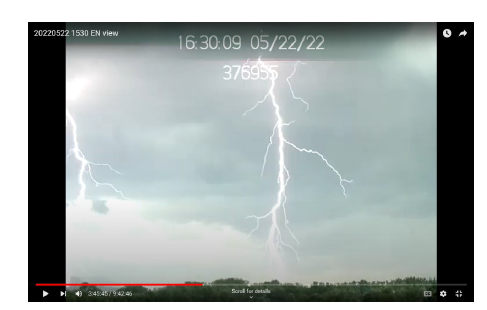In January 2022, ESSIC/CISESS Scientist Daile Zhang won a CISESS Seed Grant to evaluate NOAA’s Geostationary Lightning Mappers (GLMs) on the GOES-16 and -17 Satellites and the upgraded Mid-Atlantic Lightning Mapping Array (MALMA) using a network of low-cost and innovative atmospheric electricity and lightning measurement tools to take lightning videos. Recently, the initial Seeds Grant period ended and Zhang reported her results.
Zhang, with the help of student interns Domenic Brooks, Alex Friedman and Samantha Smith, designed and built a Raspberry Pi camera network for high-speed lightning video observations. Each Raspberry Pi camera set includes a Raspberry Pi board, which is a small single-board Linux computer, a high-quality Pi camera module with a wide-angle lens, a tripod, a monitor, a keyboard, and a mouse. The Pi cameras take high-speed videos (~90 fps) with each frame time-stamped with GPS location information (see Figure). Initially, four Raspberry Pi Cameras were set up in Maryland, and later two cameras were deployed in Arizona and one in Oklahoma. This project has continued beyond the initial Seeds Grant period and, as of June 2023, there are 16 Raspberry Pi cameras in operation in Maryland (6), North Carolina (2), Oklahoma (1), Colorado (2), and Arizona (5).

Left: Screenshot of lightning with 1/100th second time-resolution taken by the Raspberry Pi camera network on May 5, 2022.

Right: The colored dots are the GLM pixel geolocations, color-coded by energy in femtojoules. The red stars are the lightning geolocations reported by the National Lightning Detection Network (NLDN). The black diamonds are the lightning geolocations reported by the Earth Networks Total Lightning Network (ENTLN).
For each stroke identified, the time and frame number were collected in a spreadsheet along with geolocation, optical energy, altitude and other relevant parameters. The time and estimated location were used to determine whether there were any GLM or MALMA detections. Overall, more than 30 active days from different locations were collected and at least 10 days of data have been carefully examined. In total, 61 flashes and 195 strokes were analyzed. The results were presented at the 2022 GLM Science Meeting, 2022 AGU annual conference, 2022 Mid-Atlantic ChaserCon, as well as the 2023 AMS annual meeting student conference.
Zhang’s work at ESSIC focuses on evaluating and assessing space-based lightning sensors such as the GLM. She is a part of the ESSIC/CISESS Geostationary Lightning Team, which also includes Scott Rudlosky, Guangyang Fang, and Joseph Patton.






